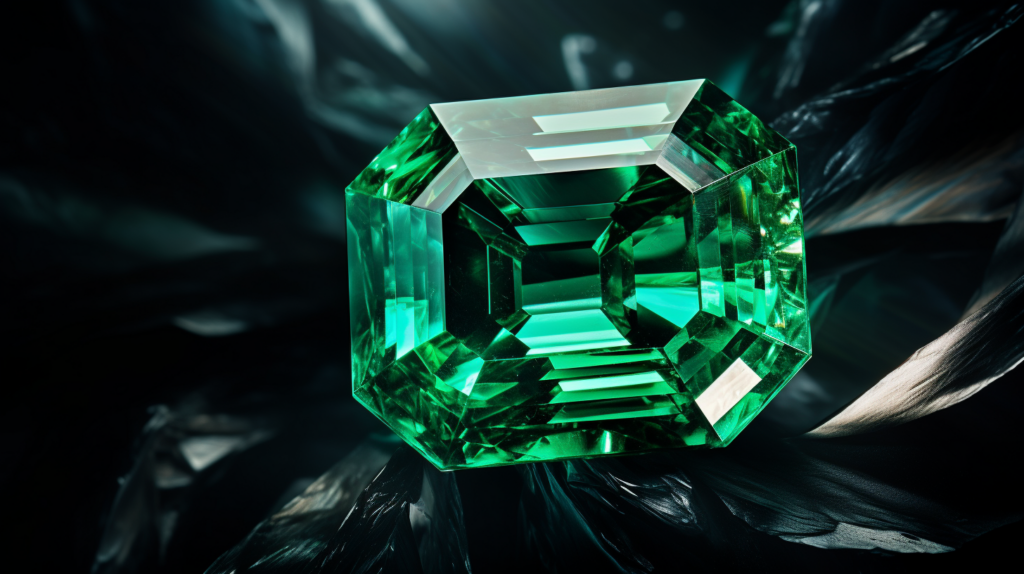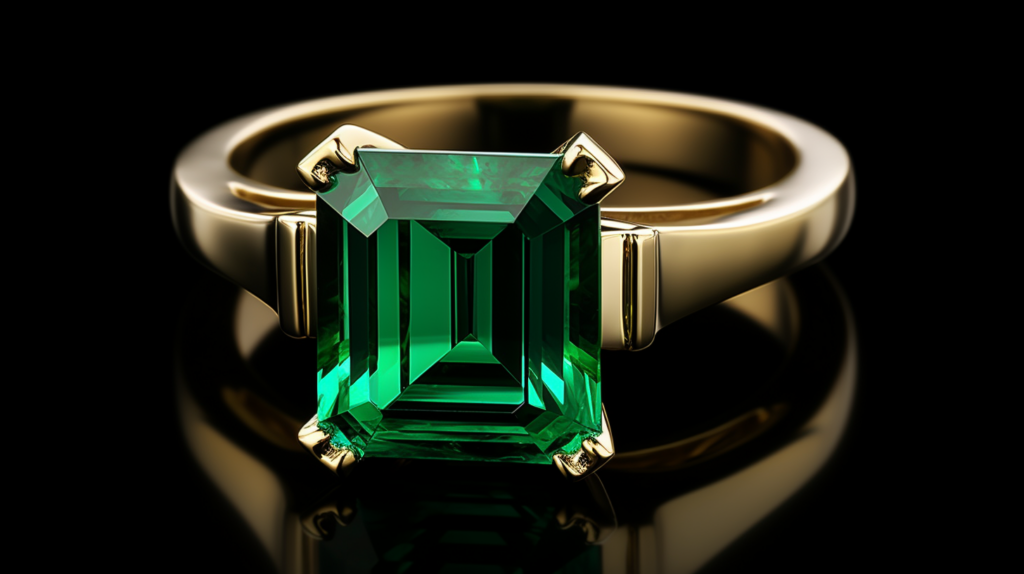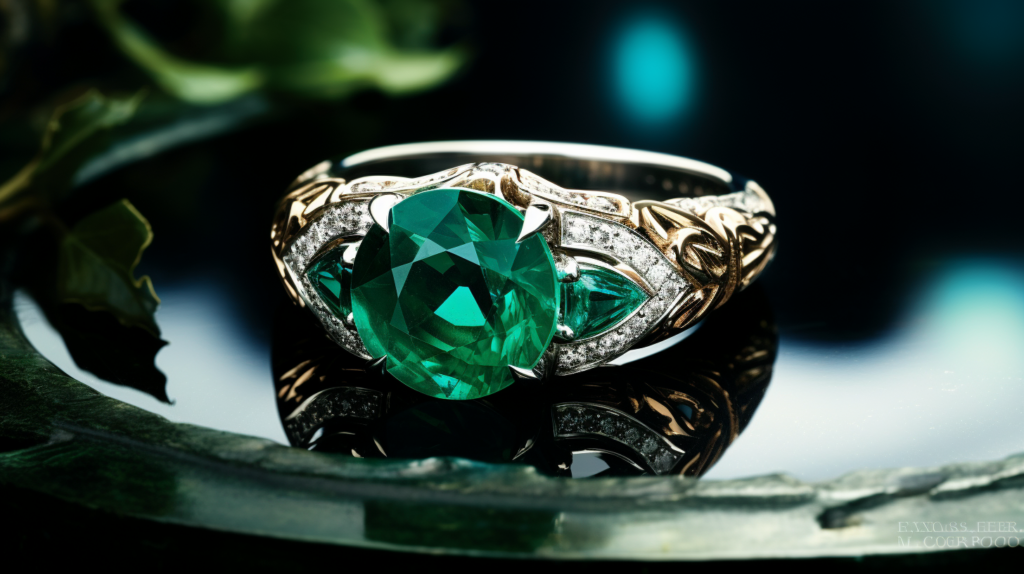Visit our ultimate Emerald Jewelry Guide! Prepare to be captivated by real emeralds. This guide will explain what makes these precious stones so intriguing and fascinating, from their pure green color that resembles spring leaves to their lengthy lifespan.
BrigtherGuide‘s Emerald Jewelry Guide covers emeralds’ history, advancements in mining, the market, and notable finds. This site is a goldmine for emerald lovers and historians interested in famous legends.
Key Takeaways
- Emeralds, known for their unique green color, originate mainly from Colombia, Zambia, Brazil, and North Carolina and are formed deep within sedimentary rocks over millions of years.
- While synthetic emeralds mimic the aesthetics of natural ones, they lack the distinct inclusions that purists cherish and that set natural emeralds apart from lab-created ones.
- The value of emeralds hinges on four key aspects: color, clarity, cut, and carat weight, with color being the central determinant of an emerald’s allure.

What Are Emeralds?
Emeralds are nature’s green wonders and the go-to precious gemstone when you think of the color green. These green beryl beauties captivate us with their deep bluish-green shades, evoking images of the world’s most lush landscapes. When you talk about a green stone that steals the spotlight, emeralds come to mind.
So, what gives these gems their iconic green colors? The answer lies in minimal amounts of chromium, vanadium, and iron. The beryl matrix and these elements—which can turn yellow in some cases—distinguish emeralds from sapphires, rubies, and other colored stones.
The geography of emeralds is fascinating. Colombia produces most emeralds worldwide. Not to be outdone, North Carolina offers some of the finest examples, showcasing the diversity of rock types, including sedimentary rocks and metamorphic rock photos, that support these green crystals.
Natural emerald production is awe-inspiring. Over millennia, the Earth’s geothermal heat and trace amounts of chromium combine in a slow-cooked process deep within its crust. This process of formation of emeralds sets them apart from synthetic or lab-created emeralds, imbuing them with unique characteristics to emeralds, like numerous inclusions that add a special appeal to each stone.
But let’s not forget the contributions of modern technology. Carroll Chatham has made strides in creating synthetic emeralds that resemble their natural counterparts. These lab-created or synthetic emeralds may lack the obvious inclusions that make natural stones unique, but they still find their way into the hearts of gemstone enthusiasts, offering a less costly alternative.
Whether you’re buying a faceted stone for special occasions or choosing from various emerald pieces to feature in your jewelry, there are a lot of characteristics of emerald to consider. Emerald quality varies, and what might be considered a flaw in other stones can be a prized characteristic in emeralds. The emerald buying guide usually highlights these elements to help buyers understand the gem’s timeless appeal and rich human history, whether set in emerald jewelry or admired as individual gem materials.

World’s Oldest Treasure
Emeralds Emeralds are more than just beautiful stones; they have a rich history that spans from the time of ancient Egyptian pharaohs to modern-day celebrities. These green emeralds have captivated many generations. In the past, these precious gemstones were even thought to prevent diseases like epilepsy. Nowadays, they’re often gifted on special occasions like weddings, symbolizing happiness and good fortune.
Emerald Production
When we talk about emerald production, it’s hard to ignore the appeal of natural emeralds. These green beryl stones are created over thousands of years within the Earth’s crust. This is all made possible through a unique process involving sedimentary rocks and small amounts of chromium. The production of emerald is so fascinating because each stone has its own unique characteristics, including a wide range of colors that differ from stone to stone.
Emerald Deposits
Famous emerald deposits can be found in diverse locations like Zambia, North Carolina, and Colombia. These geographical origins are unique in their own right. North Carolina, for instance, has some of the best emerald mines in the United States, giving it a special place in the production of emeralds. Whether big or small, emeralds used in jewelry often originate from these rich deposits.
Synthetic vs. Natural
The modern world has brought us technological advances that allow for the creation of synthetic emeralds. Brands like Chatham are known producers of these lab-created or synthetic stones. However, natural stones are often more appreciated for their numerous inclusions and unique characteristics compared to synthetic or lab-created emeralds.
This guide aims to help you find something really special about emeralds, whether you’re interested in their unique characteristics or rich history. Emeralds come in various types and qualities, from flawless and Asscher cut to Ethiopian varieties. Whether you’re shopping during regular business hours or looking for that perfect stone for a special occasion, emeralds have something to offer everyone.
What Makes Emeralds Green
Emeralds, which belong to the green beryl family, are often considered as a kind of precious gemstone that captures the essence of nature and Earth. These natural stones get their exceptional range of green colors from trace amounts of chromium and sometimes even vanadium. This unique color definition, combined with the carat weight, is what sets these green emeralds apart in the vast world of colored stones.
When it comes to maintaining the brilliance of these fragile stones, special care is needed. Cleaning them gently with a soft cloth and warm water usually does the trick. Since these emeralds can be prone to eye-visible fractures and surface-reaching fractures, it’s smart to store them separately from other gem materials like diamonds. This helps to preserve their natural beauty and rich color.
Emeralds are a blend of history, beauty, and a close relationship with nature. They are often used in jewelry items, like an Asscher emerald ring or a set of emerald pieces, making them popular choices for special occasions. It’s not just about their attractive bluish-green color; it’s also about the characteristics of emeralds, like their formation over time through the crystallization of emerald material and their numerous inclusions that make each piece unique.
The geographical origin or mining location of emeralds is significant. North Carolina is a standout producer of emeralds among North American emerald mines, boasting some of the best emerald-bearing rock. Meanwhile, Colombia is a giant in the emerald production scene, known for producing green emeralds in large amounts. These emeralds from specific regions carry an extra cost due to their high quality.
Lab-Created Alternatives
In today’s advanced age, lab-created emeralds or synthetic emeralds are becoming more common. Brands like Carroll Chatham offer gem materials that look like natural emeralds but may lack the inclusions and flaws that many purists seek in natural, flawless emeralds. These lab-created or flux-grown synthetic emeralds are often less expensive but still capture much of the beauty of natural emerald crystals.
For those considering buying an emerald, it’s wise to consult an emerald buying guide. These guides cover important aspects like carat weight, emerald quality, and other characteristics to help you make an informed decision. Whether you are exploring these gems during regular business hours at a jewelry store or at a special gemstone import event, it’s good to know that both natural and lab-created emeralds have their unique sets of characteristics and appeals.
Finally, it’s worth noting that emeralds are distinct from other green gemstones like green tourmaline and chrome tourmaline. The unique color definitions and range of these green beryl family members cement their ongoing popularity and their important role in the long stretch of human history.

Emeralds’ 4C Value
So you’re keen on emeralds, huh? Who could blame you? These green beauties, considered both natural stones and precious gemstones, turn heads and spark conversations wherever they go. When you’re looking to buy one, you’ll probably encounter the 4Cs in an emerald buying guide—those would be color, clarity, cut, and carat weight. Trust me, these are the foundation stones you’ll need to grasp if you want to know your gem’s true value.
Color
Let’s start with the showstopper. The green color of an emerald is its signature trait. These aren’t your average green stones; we’re talking famous emeralds that range from bluish-green to dark tones. The most prized emeralds sport a vivid, medium to medium-dark green without any color confusion. What makes them so green, you ask? Trace amounts of chromium and sometimes vanadium separate them from other green materials, like green quartz.
Clarity
Now, this is where emeralds stray from the path most gems take. Unlike diamonds, emeralds have what you might call “personality marks”—those would be inclusions. They’re so common that they’re almost like an emerald’s fingerprint. Found in sedimentary rocks, the formation and crystallization of emeralds give them unique characteristics. Depending on how many and what type, these inclusions can either add to or take away from the stone’s overall appeal and stability.
Cut
The cut of an emerald is practically a tale in itself. Whether you go for the classic Asscher cut or something more unique like a cushion or pear emerald, the cut can drastically change how your gem looks. It’s all about the art of the cut, a craft that people like Carroll Chatham have fine-tuned to highlight an emerald’s best features, like its attractive bluish-green color or its unique growth sectors.
Carat Weight
Last but not least, size matters. The bigger the emerald, the more you’re going to pay. That’s especially true for gems from sought-after spots like Ethiopian emerald mines or North American ones. Just remember, the carat weight is just one part of the puzzle; the overall clarity and color of the emerald also play a huge role in determining its cost for jewelry items.
Going beyond the 4Cs
But wait, there’s more. Beyond these basic grading standards, emeralds have a rich history that extends from the crowns of royalty to the hearts of gem enthusiasts celebrating special occasions. You even have lab-created or synthetic options, which have become more popular thanks to advanced technologies like flux-grown synthetic emerald production. So whether you’re eyeing an emerald jewelry set or just a singular stone, it’s crucial to appreciate the intricate characteristics that make each emerald special, no matter its origin.

A Comprehensive Look into Emerald Jewelry
Emeralds are one of the most treasured gemstones, embodying the soul of the green stone’s vivid hues. Their worth fluctuates depending on factors such as emerald production and the reputation of the producer of emeralds.
Their standing in the realm of precious gemstones is amplified by their burgeoning popularity. What sets emerald jewelry apart is not just the stone itself but the exquisite artistry behind each piece.
Now, let’s dive deeper into the multifaceted aspects that determine the value of emeralds:
Description and Factors Affecting Quality
Emerald quality is often at the forefront, with its captivating green colors taking the spotlight. The ideal emerald showcases an exceptional color, standing as a gem in the green beryl mineral family, free from any color confusion. Natural emeralds, often seen as the pinnacle of green gem materials, emanate a unique shade of green. Birthed from a diversity of rock types like sedimentary rocks, these gemstones offer their own special charm, distinctly setting them apart from other colored stones and synthetic stones.
Market Demand and Its Influence
The pulse of the market for emerald jewelry sets the tempo for its price tag. As emeralds grow in popularity, potentially fueled by articles about diamonds or even diamond discoveries that have caught public attention, their demand can rise significantly. Factors like the production of emerald, the prominence of emerald deposits in places like North Carolina, and the overall emerald quality, all entwined with global economic dynamics, play a role in market demand.
Varieties of Emerald and Their Origin
The journey of an emerald, from its initial crystallization in emerald-bearing rock to its final form, has a considerable impact on its price. Natural emeralds, which are the product of just the right amounts of chromium and optimal conditions in organic shale deep in the Earth’s crust, usually command a higher price. They feature numerous inclusions and unique characteristics of emeralds that make them stand apart from lab-created or synthetic emeralds.
Synthetic Alternatives
The green colors of flux-grown synthetic emeralds or Chatham-created gems might not have the depth or the same kinds of inclusions that natural stones possess. Another key factor influencing price is carat weight. Larger, nearly flawless emeralds with rich color and light or dark tones often fetch higher prices.
Historical and Cultural Significance
Humans share a long history with emeralds. These beautiful stones have been perceived in some cultures as protectors against ailments like epilepsy. Notable figures and institutions, such as celebrities and the National Museum of Natural History, have owned pieces featuring famous emeralds, thereby enhancing their reputation.
For those with a discerning eye and a heartfelt desire to purchase emerald jewelry for special occasions, understanding these nuances is vital. Whether you’re eyeing an Asscher emerald ring or a sophisticated cushion emerald jewelry set, every piece tells a story. This in-depth understanding transforms your chosen item into not just a piece of jewelry but also a part of history and legacy.
By having a comprehensive knowledge spanning from the gemstone’s geographical origin to its carat price and even to the advancements in lab-created emeralds, you’re not just buying a piece of jewelry. You’re investing in a treasure.
Seven Beautiful yet Delicate Engagement Ring Stones
Emerald engagement rings are super popular and for good reasons. They radiate with a vivid green color that symbolizes growth, love, and renewal. Also known as green beryls, emeralds are a precious gemstone that have been the shining star of tons of engagement rings, making special occasions even more special.
Now, when it comes to emerald production, Colombia is the big name. They are the top producer of emeralds, hands down. But don’t count out other places like Zambia, Brazil, and North Carolina. Yep, North American emerald mines, especially in North Carolina, also bring some stunning stones to the table. Colombian emeralds get extra points for their killer color and top-notch quality, thanks to the exceptional amounts of chromium they contain.
- Natural Formation: So, how do these beautiful stones come into existence? Each natural emerald tells a story, a super long story about Earth’s history, including human history. These unique stones formed over millions of years in sedimentary rocks. Crystallization creates emerald crystals in these rocks under extreme conditions.
- Size Matters: Emeralds come in all shapes and sizes, from little guys that make delicate rings to big, flashy statement pieces. How much an emerald is worth often comes down to carat weight, which can vary a lot. Whether you like cushion emeralds, pear emeralds, or Asscher emeralds, there’s something for everyone.
- What’s it Made Of?: Beyond their good looks, emeralds have a cool scientific side. They contain beryllium, which is a mineral used in a bunch of different industries. This, along with trace amounts of chromium, is what gives emeralds their mind-blowing green color, from light tones to dark tones.
So whether you’re an emerald newbie or a gem enthusiast, understanding all these different aspects, from their carat price to where they come from, can help you pick the perfect stone. Whether you go for a flawless emerald from Ethiopia or something more budget-friendly like a lab-created or synthetic emerald, you’re getting a stone that’s both drop-dead gorgeous and super interesting.

Advice For Grading Dark-Colored Gemstones
Green is the name of the game for both natural and lab-created emeralds. Like diamonds and other precious stones, the color you want is a deep, rich one. Think lush landscapes of South America, which is the biggest producer of emeralds in the world. Avoid anything with yellow beryl; it’s the bluish-green you’re after.
- Clarity: Gem clarity counts in all green stones. Just like a matrix of quartz or gold inclusions can make other gem materials unique, the same goes for emeralds. But watch out for too many inclusions or surface-reaching fractures; they can make the stone less attractive. What you want is a stone that shines, whether it’s due to common elements like mica schist or something rare like gold.
- Cut: The cut of an emerald is its own thing. Traditionalists might go for the classic emerald cut, but don’t sleep on unique options like oval or pear shapes. A well-cut cushion or Asscher emerald can really show off the stone’s brilliance, deep color definition, and the overall beauty of the green material. The cut can make a difference whether you’re looking at loose stones or set pieces.
- Carat Weight: Size can also mean a bigger price tag, especially if you’re eyeing emeralds from famous spots like North Carolina’s emerald deposits or emerging markets in Ethiopia. Bigger carat weights usually mean a higher cost, so balance is key. If you need help, consult the Gemological Institute of America’s emerald buying guide. You can balance size, quality, and price with their help.
Conclusion
In conclusion, emeralds are more than just pretty green stones. They’ve got history, having been worn by royalty and even displayed in the National Museum of Natural History. Whether you’re reading articles about diamonds or focusing solely on emerald jewelry, these gems are timeless. They’re perfect for engagement rings, standing for love, renewal, and progress. And whether you’re looking at costly options or more budget-friendly lab-created or synthetic emeralds, remember that each emerald tells a story — not just about the Earth, but about us.
Sources
BrighterGuide is dedicated to providing accurate and relevant information as you explore the wonderful world of diamonds and jewelry. To this end, our writers refer to primary information sources in building each article that appears on this website. These include, but are not limited to, published news articles, government portals, research papers, and more.
- National Jeweler. (n.d.). Gemfields cancels upcoming High-Quality Emerald auction. nationaljeweler.com. https://nationaljeweler.com/articles/12334-gemfields-cancels-upcoming-high-quality-emerald-auction
- Bernstein, B. (2023, May 1). Entranced By Emeralds: The Birthstone Of May. Forbes. https://www.forbes.com/sites/bethbernstein/2023/05/01/entranced-by-emeralds-the-birthstone-of-may
- The Natural Emerald Company – Emerald Rings & Jewelry since 1939. (n.d.). The Natural Emerald Company. https://emeralds.com/